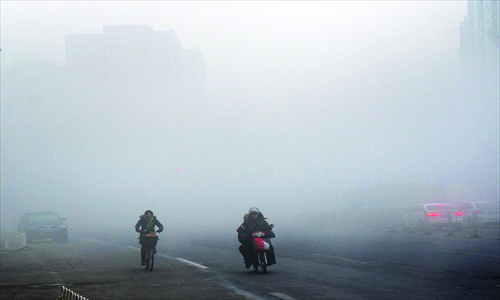HOME >> CHINA
'Poisonous chemicals' found in Jan smog
By Xu Tianran Source:Global Times Published: 2013-2-18 0:28:01

People ride to work and school amid the hazy weather in Beijing on Sunday morning. Photo: CFP
Read More in GT Daily Specials: Beijing smog contains toxic organic compounds: research
A new wave of smog descended on North China's Beijing, Tianjin and Hebei Province on Sunday, while the Chinese Academy of Sciences (CAS) announced that large amounts of poisonous chemicals were found in last month's heavy smog that choked the region.
The elements found in the prolonged smog that hit many cities in northern China in January are a combination of that of London's Great Smog in 1952, which was generated mostly by the use of coal and killed approximately 12,000 people, and the Los Angeles photochemical smog in the past century and dust aerosol, an endemic pollutant in China, according to a report published by the academy on Saturday.
Large amounts of nitrogen-containing organic compounds, a main element in the photochemical smog produced by the reaction between sunlight and exhaust from vehicles and industrial fumes, were found in the academy's research.
Photochemical smog can lead to heart and lung illness, eye irritation and respiratory problems.
The report came amid alarm over a new wave of smog that hit Beijing, Tianjin and the provinces of Hebei and Henan early on Sunday, disrupting highway traffic and flights.
The air quality index showed extreme pollution in five monitoring sites at 8 am in Shijiazhuang, the provincial capital of Hebei. Moderate or serious air pollution was reported in many parts of Beijing, with a visibility of no more than 500 meters in the early morning, said the Beijing Municipal Environmental Monitoring Center.
The CAS research found that the main contributing factors to the smog are a lack of wind, abundant water vapor, floating dust and pollutant emissions.
According to the report, vehicle exhaust made up a quarter of the source of hazardous particles measuring 2.5 microns in Beijing last month, while coal consumption and pollutants blown in from outside Beijing each contributed 20 percent.
Lü Daren, an academician at the Institute of Atmospheric Physics under the CAS, told the Global Times that the major cause was human activities that discharge pollutants.
The severe air pollution in January has also strengthened public calls for fewer fireworks during Spring Festival. Beijing also launched a weather index for fireworks on February 5, hoping to persuade citizens to refrain from setting off firecrackers when the weather did not favor the diffusion of pollutants.
A total of 310 million boxes of firecrackers were sold in the first six days of the Spring Festival holiday, a 45 percent decrease compared with the same period in the last Spring Festival period.
"Combined with the relatively still air, pollutants from firecrackers will contribute to the smog, but in general, most of the pollutants in the smog come from oil and coal consumption," Lü said.
For the entire Beijing, Tianjin, Hebei area, industrial production and coal consumption should be strictly controlled to reduce the discharge of sulfur and dust. Diesel emissions should also be strictly limited, the CAS report suggested.
Posted in: Society